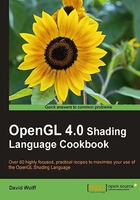
Introduction
The OpenGL Shading Language (GLSL) Version 4.0 brings unprecedented power and flexibility to programmers interested in creating modern, interactive, graphical programs. It allows us to harness the power of modern Graphics Processing Units (GPUs) in a straightforward way by providing a simple yet powerful language and API. Of course, the first step towards using the OpenGL Shading Language version 4.0 is to create a program that utilizes the latest version of the OpenGL API. GLSL programs don't stand on their own, they must be a part of a larger OpenGL program. In this chapter, I will provide some tips on getting a basic OpenGL/GLSL program up and running and some techniques for communication between the OpenGL application and the shader (GLSL) program. There isn't any GLSL programming in this chapter, but don't worry, we'll jump into GLSL with both feet in Chapter 2. First, let's start with some background.
The OpenGL Shading Language
The OpenGL Shading Language (GLSL) is now a fundamental and integral part of the OpenGL API. Going forward, every program written using OpenGL will internally utilize one or several GLSL programs. These "mini-programs" written in GLSL are often referred to as shader programs , or simply shaders. A shader program is one that runs on the GPU, and as the name implies, it (typically) implements the algorithms related to the lighting and shading effects of a 3-dimensional image. However, shader programs are capable of doing much more than just implementing a shading algorithm. They are also capable of performing animation, tessellation, and even generalized computation.
Shader programs are designed to be executed directly on the GPU and often in parallel. For example, a fragment shader might be executed once for every pixel, with each execution running simultaneously on a separate GPU thread. The number of processors on the graphics card determines how many can be executed at one time. This makes shader programs incredibly efficient, and provides the programmer with a simple API for implementing highly parallel computation.
The computing power available in modern graphics cards is impressive. The following table shows the number of shader processors available for several models in the NVIDIA GeForce 400 series cards (source: http://en.wikipedia.org/wiki/Comparison_of_Nvidia_graphics_processing_units).

Shader programs are intended to replace parts of the OpenGL architecture referred to as the fixed-function pipeline . The default lighting/shading algorithm was a core part of this fixed-function pipeline. When we, as programmers, wanted to implement more advanced or realistic effects, we used various tricks to force the fixed-function pipeline into being more flexible than it really was. The advent of GLSL helped by providing us with the ability to replace this "hard-coded" functionality with our own programs written in GLSL, thus giving us a great deal of additional flexibility and power. For more details on the programmable pipeline, see the introduction to Chapter 2.
In fact, recent (core) versions of OpenGL not only provide this capability, but they require shader programs as part of every OpenGL program. The old fixed-function pipeline has been deprecated in favor of a new programmable pipeline, a key part of which is the shader program written in GLSL.
Profiles: Core vs. Compatibility
OpenGL version 3.0 introduced a deprecation model, which allowed for the gradual removal of functions from the OpenGL specification. Functions or features can now be marked as deprecated, meaning that they are expected to be removed from a future version of OpenGL. For example, immediate mode rendering using glBegin/glEnd was marked deprecated in version 3.0 and removed in version 3.1.
In order to maintain backwards compatibility, the concept of compatibility profiles was introduced with OpenGL 3.2. A programmer who is writing code intended for a particular version of OpenGL (with older features removed) would use the so-called core profile . Someone who also wanted to maintain compatibility with older functionality could use the compatibility profile.
Note
It may be somewhat confusing that there is also the concept of a full vs. forward compatible context, which is distinguished slightly from the concept of a core vs. compatibility profile. A context that is considered forward compatible basically indicates that all deprecated functionality has been removed. In other words, if a context is forward compatible, it only includes functions that are in the core, but not those that were marked as deprecated. A full context supports all features of the selected version. Some window APIs provide the ability to select full or forward compatible status along with the profile.
The steps for selecting a core or compatibility profile are window system API dependent. For example, in recent versions of Qt (at least version 4.7), one can select a 4.0 core profile using the following code:
QGLFormat format;
format.setVersion(4,0);
format.setProfile(QGLFormat::CoreProfile);
QGLWidget *myWidget = new QGLWidget(format);
Tip
Downloading the example code
You can download the example code files for all Packt books you have purchased from your account at http://www.PacktPub.com. If you purchased this book elsewhere, you can visit http://www.PacktPub.com/support and register to have the files e-mailed directly to you.
All programs in this book are designed to be compatible with an OpenGL 4.0 core profile.